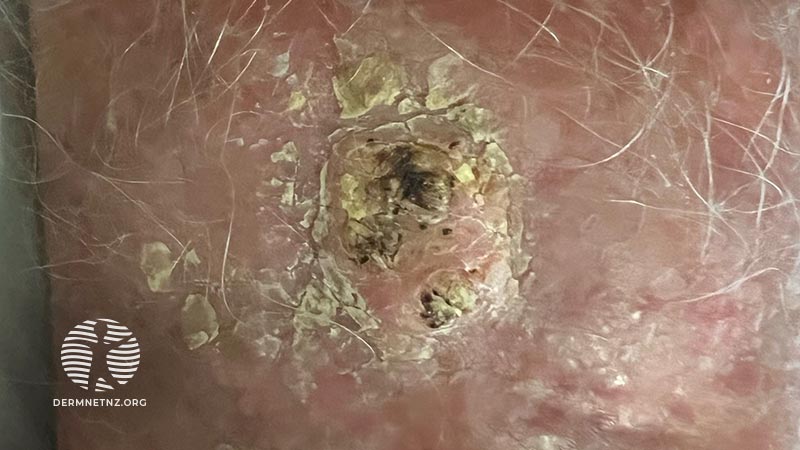Main menu
Common skin conditions

NEWS
Join DermNet PRO
Read more
Quick links
Retired farmer with crusted lesion and cellulitis on the lower leg
Last reviewed: October 2023
Author: Dr Stanley Leong, Dermatology and Paediatric Registrar, NZ
Reviewing dermatologist: Dr Ian Coulson (2023).
Edited by the DermNet content department

Background
A 90-year-old man presented with unilateral lower leg cellulitis. He also had a lesion on his right lower leg that had been growing in size over the last few months and becoming more tender.
He previously worked as a farmer and spent a lot of time under the sun during his working years.
On examination, he had extensive erythema with significant oedema over the right lower leg, tracking up to the inner thigh. He also had a nodular, hyperkeratotic (crusted) lesion on his right lower leg that was tender on palpation.
What is the likely diagnosis for the lesion?
Cutaneous squamous cell carcinoma (SCC) usually begins as a tender erythematous papule or nodule that may have a variable amount of hyperkeratosis. Older lesions may ulcerate.
It is generally located on sun-exposed sites and usually enlarges over a period of months. They can arise in old scars, and in areas that have been subject to irradiation.
What is the recommended treatment?
Cutaneous SCC nearly always requires surgical excision.
Other methods of removal include:
- Shave, curettage, and electrocautery for low-risk tumours on the trunk and limbs
- Aggressive cryotherapy for very small, thin, low-risk tumours
- Mohs micrographic surgery for large facial lesions with indistinct margins or recurrent tumours
- Radiotherapy for an inoperable tumour, patients unsuitable for surgery, or as an adjuvant therapy.
What are the common complications?
Cutaneous SCC can bleed or ulcerate if the lesion continues to grow. It can also become a nidus for infection such as cellulitis.
Cutaneous SCC can also be invasive. In some cases, it may metastasise to both the lymph nodes and beyond, and be fatal.
